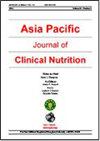Diaphragm thickness on computed tomography for nutritional assessment and hospital stay prediction in critical COVID-19.
IF 1.3
4区 医学
Q4 NUTRITION & DIETETICS
Asia Pacific journal of clinical nutrition
Pub Date : 2022-03-01
DOI:10.6133/apjcn.202203_31(1).0004
引用次数: 5
Abstract
BACKGROUND AND OBJECTIVES To evaluate the significance of diaphragm thickness (DT) in assessing the nutritional status and predicting the length of hospital stay (LOS) of patients with COVID-19. METHODS AND STUDY DESIGN The data of 212 patients with severe and critical COVID-19 in Wuhan, China, were retrospectively analyzed. Computed tomography (CT)-obtained DT was measured in cross-sectional images of the mediastinal window at the level of the outlet of the celiac trunk at admission and at 2 weeks, then the rate of change in DT(RCDT) at 2 weeks was calculated. Nutritional risk and malnutrition were evaluated at admission. RESULTS A total of 91 patients were involved in the study. The mean DT was 3.06±0.58 mm (3.15±0.63 mm in male and 2.93±0.50 mm in female). DT was significantly negatively correlated with malnutrition based on Global Leadership Initiative on Malnutrition (GLIM) criteria (r=-0.324, p=0.002), Nutritional Risk Screening 2002 (NRS-2002) score (r=-0.364, p=0.000) and the Malnutrition Universal Screening Tool (MUST) score (r=-0.326, p=0.002) at admission. For the prediction of LOS ≥4 weeks in patients with COVID-19, the area under the ROC curve (AUC) of the RCDT at 2 weeks was 0.772, while the AUCs of DT, NRS-2002, MUST and Nutrition Risk in Critically Ill scores at admission were 0.751, 0.676, 0.638 and 0.699 respectively. According to the model of multiple linear regression analysis, the DT at admission (β=-0.377, p=0.000), RCDT at 2 weeks (β =-0.323, p=0.001), and mechanical ventilation (β=0.192, p=0.031) were independent risk factors contributed to LOS. CONCLUSIONS CT-obtained DT can be used as a dynamic assessment tool for evaluating the nutritional status of patients in isolation wards for COVID-19.计算机断层扫描隔膜厚度用于危重新冠肺炎患者的营养评估和住院预测。
背景与目的评价膈肌厚度(DT)在评估COVID-19患者营养状况和预测住院时间(LOS)中的意义。方法与研究设计回顾性分析了中国武汉212例重症和危重症COVID-19neneneea患者的数据。在入院时和2周时,在腹腔干出口水平的纵隔窗的横截面图像中测量计算机断层扫描(CT)获得的DT,然后计算2周时DT的变化率(RCDT)。入院时评估营养风险和营养不良。结果共有91名患者参与了这项研究。平均DT为3.06±0.58 mm(男性3.15±0.63 mm,女性2.93±0.50 mm)。根据全球营养不良领导倡议(GLIM)标准(r=-0.324,p=0.002)、2002年营养风险筛查(NRS-2002)评分(r=-0.364,p=0.000)和入院时营养不良通用筛查工具(MUST)评分(r=-0.326,p=0.002。对于新冠肺炎患者LOS≥4周的预测,2周时RCDT的ROC曲线下面积(AUC)为0.772,而入院时DT、NRS-2002、MUST和危重症营养风险评分的AUC分别为0.751、0.676、0.638和0.699。根据多元线性回归分析模型,入院时的DT(β=-0.377,p=0.000)、2周时的RCDT(β=0.323,p=0.001)和机械通气(β=0.192,p=0.031)是导致LOS的独立危险因素。
本文章由计算机程序翻译,如有差异,请以英文原文为准。
求助全文
约1分钟内获得全文
求助全文
来源期刊
CiteScore
2.50
自引率
7.70%
发文量
58
审稿时长
6-12 weeks
期刊介绍:
The aims of the Asia Pacific Journal of Clinical Nutrition
(APJCN) are to publish high quality clinical nutrition relevant research findings which can build the capacity of
clinical nutritionists in the region and enhance the practice of human nutrition and related disciplines for health
promotion and disease prevention. APJCN will publish
original research reports, reviews, short communications
and case reports. News, book reviews and other items will
also be included. The acceptance criteria for all papers are
the quality and originality of the research and its significance to our readership. Except where otherwise stated,
manuscripts are peer-reviewed by at least two anonymous
reviewers and the Editor. The Editorial Board reserves the
right to refuse any material for publication and advises
that authors should retain copies of submitted manuscripts
and correspondence as material cannot be returned. Final
acceptance or rejection rests with the Editorial Board

 求助内容:
求助内容: 应助结果提醒方式:
应助结果提醒方式:


